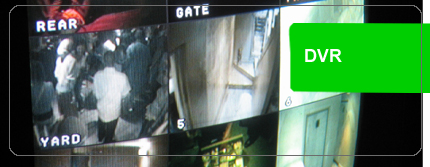


 |
 |
||
 |
|||
|
|
|||

Non-PC based DVR( or referred to as Stand-alone DVR) is very much different from PC-based DVR, and it does not include all of PC components but just includes a board and software specially designed to have a function of recording. Stand-alone DVR is very stable in operation, and provides all of functions available in PC-based DVR and conventional analog CCTV devices. Current production cost of Stand-alone DVR is relatively high compared with PC-based DVR, because it is still fairly new in the market and overall production volume is not so big as PC-based DVRs. We are sure Non-PC based DVRs shall be very popular in the market soon, and unit price can be decreased so much that it may be in a stronger position in competition with PC-based DVRs in terms of not only performance and stability but also price competitiveness.
Time lapse VCR (TL VCR)
Time lapse video recording
JPEG
Duplex
Field
Frame
![]()
A video recorder, most often in VHS format, that can prolong the video recording on a single tape up to 960 hours (this refers to a 180 min tape). This type of VCR is often used in CCTV systems. The principle of operation is very simple ? instead of having the video tape travel at a constant speed of 2.275 cm/s (which is the case with the domestic models of VHS VCRs), it moves with discrete steps that can be controlled. Time Lapse VCRs have a number of other special functions very useful in CCTV, such as external alarm trigger, time and date superimposed on the video signal,
alarm search and so on.
![]()
The intermittent recording of video signals at intervals to extend the recording time of the recording medium. It is usually measured in reference to a 3-hr (180-min) tape.
![]()
Joint Photographic Experts Group. A group that has recommended a compression algorithm for still digital images that can compress with ratios of over 10:1. Also the name of the format itself.
![]()
A communication system that carries information in both direction is called a duplex system. In CCTV, duplex is often used to describe the type of multiplexer that can perform two functions simultaneously, recording in multiplex mode and playback in multiplex mode. It can also refer to duplex communication between a matrix switcher and a PTZ site driver, for example.
![]()
Refers to one-half of the TV frame that is composed of either all odd or even lines. In CCIR systems each field is composed of 625/2 = 312.5 lines, in EIA systems 525/2 = 262.5 lines. There are 50 fields/second in CCIR/PAL, and 60 in the EIA/NTSC TV system.
![]()
(See also Field). Refers to a composition of lines that make one TV frame. In CCIR/PAL TV system one frame is composed of 625 lines, while in EIA/NTSC TV system of 525 lines. There are 25 frames/second in the CCIR/PAL and 30
in the EIA/NTSC TV system.